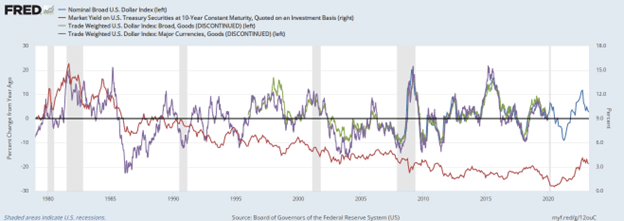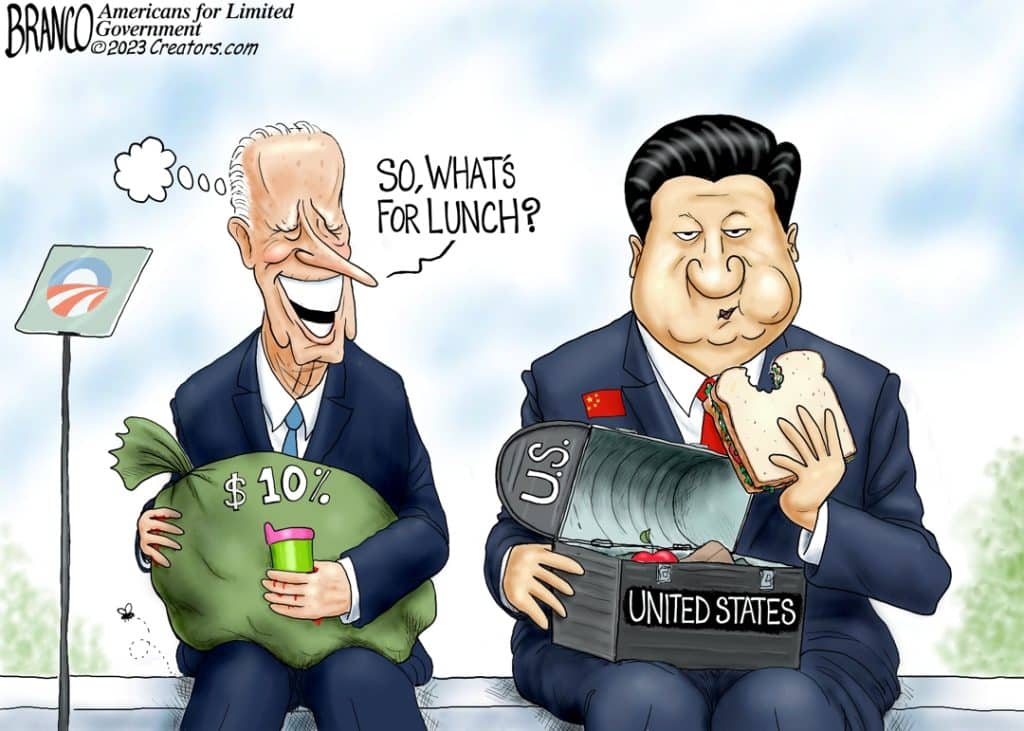April 11, 2023
Permission to republish original opeds and cartoons granted.
China has dumped $150 billion of U.S. treasuries since Jan. 2022. Is it a prelude to war?

By Robert Romano
Since Jan. 2022, China has reduced its U.S. treasuries held outright, from $1.03 trillion to $859 billion in Jan. 2023, a 16.8 percent decrease, according to the latest data compiled by the U.S. Treasury of foreign holders of U.S. securities.
This comes atop a further decrease from its peak in Nov. 2013 at more than $1.3 trillion, bringing the total decrease to 34.7 percent the past decade. But does it matter?
The recent shift came as interest rates are rising in the U.S. in its own bid to combat inflation brought upon by printing some $6 trillion to offset low consumer demand during Covid, which also resulted in production halts and economic lockdowns — too much money chasing to few goods.
But the catalyst appears to have been Russia’s invasion of Ukraine. That is when the drawdown began, and only after the invasion did the Federal Reserve begin hiking its own interest rates for lending to banks. Amid the war, there was a flight to safety as the dollar temporarily strengthened as investors and financial institutions, benefiting from the higher yields.
But this has still kept U.S. treasuries rates — the 10-year is at 3.4 percent as of this writing — below that of the consumer inflation rate, still at 6 percent but it has been steadily dropping after peaking at 9.1 percent in June 2022, with another release by the Bureau of Labor Statistics coming on April 12. Now the Fed is nearing the end of its rate-hiking and different forces will be at play as the world gears up for what appears to be an imminent recession.
As inflation gets below that of yields, interest rates will begin to drop, but unemployment usually rises, too, prompting a further flight to safety, usually away from equities and into things like gold and treasuries. This is the final strengthening of the dollar that usually signals the recession at hand. Confidence in markets is temporarily shaken, and money flows to perceived safety—into dollar-denominated assets like treasuries.

From there, with the recession, the Fed will usually begin cutting interest rates as inflation falls. This frees up credit for banks to begin lending again at lower rates. Consumers will respond to the relatively lower rates, but usually only after clearing their debt from the prior cycle. The past two cycles, the Federal Reserve has used near-zero percent interest rates and further engaged in the practice of quantitative easing to thaw markets, purchasing treasuries with cash, thereby incentivizing the banks to buy something more productive than government bonds.
That’s all context. When owners of treasuries are selling more than they are buying, interest rates can rise, and when they buy more than they are selling, interest rates will fall.
But could China really impact that process all that much? In 2019, the South China Morning Post’s Karen Yeung warned, “China could strike back by dumping its vast holdings of U.S. government debt. Flooding the market with Treasuries would push down U.S. bond prices and cause the yields to spike. That would make it more costly for U.S. companies and consumers to borrow, in turn depressing America’s economic growth.”
But is that just a fantasy? In theory, dumping dollar denominated assets should weaken the dollar, resulting in higher inflation and interest rates, but what typically happens is that eventually increases the incentive to purchase U.S. bonds.
The real question is that of firepower. In 2013, with its peak holdings of $1.3 trillion of U.S. treasuries, China was the single largest debt holder, owning 10.7 percent of the $12.2 trillion of publicly traded debt (the overall debt was $17.2 trillion but that includes non-marketable treasuries held by the Social Security, Medicare and other trust funds).
That was China’s high water mark, whereas, today, the debt is much larger now. With $859 billion of treasuries, China owns just 3.5 percent of the $24.6 trillion of the publicly traded national debt (with the overall debt now north of $31.4 trillion).
Is it a paper dragon?
It went from 10.7 percent of the publicly traded debt to 3.5 percent. Simply put, if China sold all of that tomorrow, it would almost certainly be disruptive: interest rates would temporarily jump. But we’re not Greece. We can print our own money, and so the Fed would almost certainly intervene by purchasing any excess bonds. The danger would be if China and other foreign actors all attempted to do this at the same time in a bid to weaken the U.S. economy and financial system — a coordinated attack that would usually be a prelude to war. It seems far-fetched.
The foreign institutional share of the overall national debt has been steadily declining for 15 years since the financial crisis and Great Recession. In the Dec. 2008, foreign central banks and financial institutions owned $3 trillion out of the $9.9 trillion national debt, or 30.8 percent. In Jan. 2023, they owned $7.4 trillion out of the $31.4 trillion debt, or 23.5 percent.
If the goal was to stockpile treasuries only to dump them at the end, it seems much of the window passed after the financial crisis. Now, the much of the risk is concentrated in U.S. financial institutions, retirement funds and other mutual funds, with its share of treasuries rising from about 17 percent in 2008, or $1.7 trillion, to a massive $11.9 trillion, or 38 percent today — the largest single holder of the debt.
Another factor to consider is that as the dollar weakens because dollar assets are dumped, other currencies like the yuan will strengthen, hurting the trade advantage that export economies like China are able to exert. The cost of Chinese goods in the U.S. would increase, harming China’s economy.
Meaning the question really boils down to trade. Does China still want to maintain its trade advantage with the U.S.? If so, failingly attempting to crash the dollar might actually be counterproductive, since American made goods would become relatively cheaper.
On the other hand, a complete divestiture of treasuries by China after sanctions were levied on Russia following its invasion of Ukraine in 2022 could indeed be a prelude to war, indicating Beijing wanted to get back as much of its money as possible to fuel a move, say, on Taiwan — the Chinese navy is currently encircling Taiwan — since one of the first things the U.S. would do is simply end all payments to Chinese holders of the debt. As always, it is about what sort of future Beijing wants for itself and its people. It appears it can have the benefits of trade with the U.S., or war, but not both.
Robert Romano is the Vice President of Public Policy at Americans for Limited Government Foundation.
To view online: https://dailytorch.com/2023/04/china-has-dumped-150-billion-of-u-s-treasuries-since-jan-2022-is-it-a-prelude-to-war/
Cartoon: Lunch Time
By A.F. Branco

Click here for a higher level resolution version.
To view online: https://dailytorch.com/2023/04/cartoon-lunch-time/

